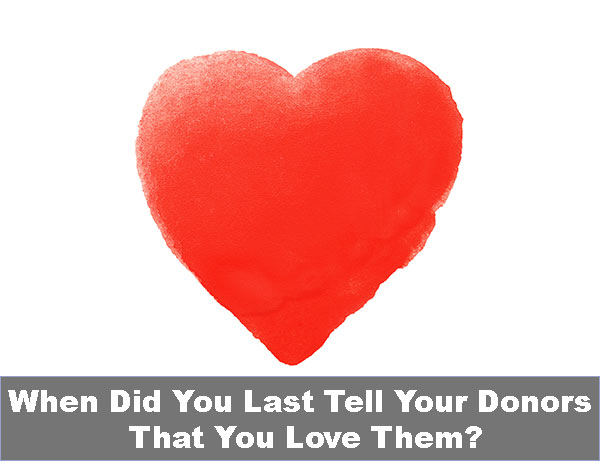Is donor attrition the dirty secret in your nonprofit world? Why do some nonprofits retain their loyal donors, building lifelong, mutually rewarding relationships, while others never get further than the first gift? Unfortunately, some nonprofits have a tendency to view their supporters as a collective whole; the donors – a vast, faceless, pool of potential resources. But donors are human too, humans who show they care by giving to our missions. In return, they want us to care about them.
What we need to do is show our donors “the love” by demonstrating our concern for their thoughts and feelings. We need to show how we value their contributions to our cause and gain their trust by keeping our promises.
There is a connection that unfolds over time between a nonprofit and their donor – a unique relationship. These are people who freely give for the public good; help them see the ways they’ve made a difference. We need to listen to our supporters and think of them as members of our family.
What Giving Means to Donors
Donors begin their philanthropic journey aiming to make the world a better place and intending to make a difference. Philanthropy has, at its roots, a love for mankind and many studies have confirmed what we’ve known all along: giving is good for people, making us more successful, healthier and happier.
When you ask for donations, you offer an opportunity to join with you in doing something wonderful. This opportunity is a gift and when donors act on your offer and donate, be quick to thank them personally so they can experience the joy of their generosity. Follow up those feel-good emotions as soon as possible with another thank you and a brief story of the impact the gift has had.
It’s not about the money, it’s about the relationship. The gift is only the by-product of a successful relationship; get that right and the money will keep coming. The development office doesn’t just collect funds – it’s the aide that helps donors find meaning and fulfillment through their financial commitment.
Also read: Who to Ask for Donations
The Impact of Donations
As important as a great relationship is, a donor needs to know what impact their donation has had. How else can that feel-good emotion be extended? Even if your donor relationship is great – they like you, you like them – if their money isn’t making an impact, they’ll lose the joy and stop funding your cause.
Connect the donor to the impact of the donation by telling stories illustrating how their money helped in specific situations. Donors who’ve experienced this first-hand say it’s highly effective, motivating them to give more generously. One benefactor described getting an actual sense of joy, knowing their gift had accomplished something positive.
To keep the thrill of giving fresh, donors just want to know that their giving produces results. The simple act of taking a donor out for coffee to talk about how their gifts helped the nonprofit move forward will motivate more donations. Keep donors loyal through effective stewardship and never underestimate the value of donor loyalty to your cause.
Keep Your Donor Happy
This survey (which tracked 2,840 American nonprofits) released last year, discovered nonprofits are losing donors faster than they can find them. Across the sector, for every 100 donors gained, another 105 donors were lost and more than seven out of ten new donors fell away. The total attrition of all donors was 61%.
Many organizations struggle to keep their doors open. For nonprofits losing both donors and funds, proactive steps must be taken to stop the drain of donors. This is the best and most cost-effective strategy for increasing the fundraising bottom line.
Put Donor Love in the Budget
In today’s fast-paced nonprofit industry, technology and social media have changed the way we do business. New tactics to reach would-be supporters for your cause have to be developed but there’s only so much time in a day. And when you have those targeted supporters on board, good stewardship has to kick in. Adding extra work to an already overloaded schedule won’t help your competitive edge.
But we’re a nonprofit, what competitive edge do we need? Think about how your competition can affect your nonprofit. With the current trend of larger gifts to fewer charities, your competition (who’s a stewardship dynamo) can hurt you more than ever before (when stewardship was largely ignored). Your disgruntled donor can easily become their loyal supporter.
Knowing that it costs less to keep and encourage your current donor than to attract a new one, more resources have to be funneled to fundraising and marketing. More will need to be spent on stewardship, more staff committed to building meaningful relationships, and this means getting more relaxed about higher overheads.
One way nonprofits can pay back their donors is by connecting them to the bigger picture. Show your donors that you know them by understanding their motivations. Appreciate them, empathize with them and treat them as you would want your friends to treat you. Friends remember your birthday, think of you at Thanksgiving, and stay in touch. When you need something, a friend is hurt if you don’t let them know you have a need. Make your donors into friends then make your friends part of the family.
It’s never too late to start, as this year winds to a close, to give your donors and supporters a warm rosy glow that will keep them glowing through the years. Tell them that you love them…

